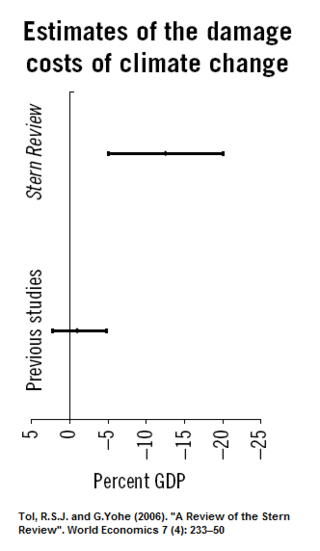
Environmental economics is a sub-field of economics concerned with environmental issues. It has become a widely studied subject due to growing environmental concerns in the twenty-first century. Environmental economics "undertakes theoretical or empirical studies of the economic effects of national or local environmental policies around the world. ... Particular issues include the costs and benefits of alternative environmental policies to deal with air pollution, water quality, toxic substances, solid waste, and global warming."
The value of life is an economic value used to quantify the benefit of avoiding a fatality. It is also referred to as the cost of life, value of preventing a fatality (VPF), implied cost of averting a fatality (ICAF), and value of a statistical life (VSL). In social and political sciences, it is the marginal cost of death prevention in a certain class of circumstances. In many studies the value also includes the quality of life, the expected life time remaining, as well as the earning potential of a given person especially for an after-the-fact payment in a wrongful death claim lawsuit.
Cost–benefit analysis (CBA), sometimes also called benefit–cost analysis, is a systematic approach to estimating the strengths and weaknesses of alternatives. It is used to determine options which provide the best approach to achieving benefits while preserving savings in, for example, transactions, activities, and functional business requirements. A CBA may be used to compare completed or potential courses of action, and to estimate or evaluate the value against the cost of a decision, project, or policy. It is commonly used to evaluate business or policy decisions, commercial transactions, and project investments. For example, the U.S. Securities and Exchange Commission must conduct cost-benefit analyses before instituting regulations or deregulations.
Contingent valuation is a survey-based economic technique for the valuation of non-market resources, such as environmental preservation or the impact of externalities like pollution. While these resources do give people utility, certain aspects of them do not have a market price as they are not directly sold – for example, people receive benefit from a beautiful view of a mountain, but it would be tough to value using price-based models. Contingent valuation surveys are one technique which is used to measure these aspects. Contingent valuation is often referred to as a stated preference model, in contrast to a price-based revealed preference model. Both models are utility-based. Typically the survey asks how much money people would be willing to pay to maintain the existence of an environmental feature, such as biodiversity.
Ecosystem valuation is an economic process which assigns a value to an ecosystem and/or its ecosystem services. By quantifying, for example, the human welfare benefits of a forest to reduce flooding and erosion while sequestering carbon, providing habitat for endangered species, and absorbing harmful chemicals, such monetization ideally provides a tool for policy-makers and conservationists to evaluate management impacts and compare a cost-benefit analysis of potential policies. However, such valuations are estimates, and involve the inherent quantitative uncertainty and philosophical debate of evaluating a range non-market costs and benefits.

Ecosystem services are the many and varied benefits to humans provided by the natural environment and healthy ecosystems. Such ecosystems include, for example, agroecosystems, forest ecosystem, grassland ecosystems, and aquatic ecosystems. These ecosystems, functioning in healthy relationships, offer such things as natural pollination of crops, clean air, extreme weather mitigation, and human mental and physical well-being. Collectively, these benefits are becoming known as ecosystem services, and are often integral to the provision of food, the provisioning of clean drinking water, the decomposition of wastes, and the resilience and productivity of food ecosystems.

A shadow price is the monetary value assigned to an abstract or intangible commodity which is not traded in the marketplace. This often takes the form of an externality. Shadow prices are also known as the recalculation of known market prices in order to account for the presence of distortionary market instruments. Shadow prices are the real economic prices given to goods and services after they have been appropriately adjusted by removing distortionary market instruments and incorporating the societal impact of the respective good or service. A shadow price is often calculated based on a group of assumptions and estimates because it lacks reliable data, so it is subjective and somewhat inaccurate.

The economic analysis of climate change explains how economic thinking, tools and techniques are applied to calculate the magnitude and distribution of damage caused by climate change. It also informs the policies and approaches for mitigation and adaptation to climate change from global to household scales. This topic is also inclusive of alternative economic approaches, including ecological economics and degrowth. In a cost–benefit analysis, the trade offs between climate change impacts, adaptation, and mitigation are made explicit. Cost–benefit analyses of climate change are produced using integrated assessment models (IAMs), which incorporate aspects of the natural, social, and economic sciences. The total economic impacts from climate change are difficult to estimate, but increase for higher temperature changes.
The travel cost method of economic valuation, travel cost analysis, or Clawson method is a revealed preference method of economic valuation used in cost–benefit analysis to calculate the value of something that cannot be obtained through market prices. The aim of the method is to calculate willingness to pay for a constant price facility. The technique was first suggested by the statistician Harold Hotelling in a 1947 letter to the director of the National Park Service of the United States for a method to measure the benefit of National Parks to the public. The method was further refined by Trice and Wood (1958) and Clawson (1959). The technique is one approach to the estimation of a shadow price.

Environmental goods are typically non-market goods, including clean air, clean water, landscape, green transport infrastructure, public parks, urban parks, rivers, mountains, forests, and beaches. Environmental goods are a sub-category of public goods. Concerns with environmental goods focus on the effects that the exploitation of ecological systems have on the economy, the well-being of humans and other species, and on the environment. Users not having to pay an upfront cost and external factors like pollution that can damage environmental goods indefinitely are some of the challenges in protecting environmental goods.
The Stern Review on the Economics of Climate Change is a 700-page report released for the Government of the United Kingdom on 30 October 2006 by economist Nicholas Stern, chair of the Grantham Research Institute on Climate Change and the Environment at the London School of Economics (LSE) and also chair of the Centre for Climate Change Economics and Policy (CCCEP) at Leeds University and LSE. The report discusses the effect of global warming on the world economy. Although not the first economic report on climate change, it is significant as the largest and most widely known and discussed report of its kind.
Non-use value is the value that people assign to economic goods even if they never have and never will use it. It is distinguished from use value, which people derive from direct use of the good. The concept is most commonly applied to the value of natural and built resources.
The social cost of carbon (SCC) is the marginal cost of the impacts caused by emitting one extra tonne of carbon emissions at any point in time. The purpose of putting a price on a ton of emitted CO2 is to aid policymakers or other legislators in evaluating whether a policy designed to curb climate change is justified. The social cost of carbon is a calculation focused on taking corrective measures on climate change which can be deemed a form of market failure. Latest studies calculate costs of more than US$300 per ton of CO2. The only governments which use the SCC are in North America. Because of politics the SCC is different from a carbon price. The Intergovernmental Panel on Climate Change suggested that a carbon price of $100/tCO2 could reduce global GHG emissions by at least half the 2019 level by 2030.

The Economics of Ecosystems and Biodiversity (TEEB) was a study led by Pavan Sukhdev from 2007 to 2011. It is an international initiative to draw attention to the global economic benefits of biodiversity. Its objective is to highlight the growing cost of biodiversity loss and ecosystem degradation and to draw together expertise from the fields of science, economics and policy to enable practical actions. TEEB aims to assess, communicate and mainstream the urgency of actions through its five deliverables—D0: science and economic foundations, policy costs and costs of inaction, D1: policy opportunities for national and international policy-makers, D2: decision support for local administrators, D3: business risks, opportunities and metrics and D4: citizen and consumer ownership.

The economics of climate change mitigation is a contentious part of climate change mitigation – action aimed to limit the dangerous socio-economic and environmental consequences of climate change.
In cost–benefit analysis and social welfare economics, the term option value refers to the value that is placed on private willingness to pay for maintaining or preserving a public asset or service even if there is little or no likelihood of the individual actually ever using it. The concept is most commonly used in public policy assessment to justify continuing investment in parks, wildlife refuges and land conservation, as well as rail transportation facilities and services. It is also recognized as an element of the total economic value of environmental resources.

Ian Bateman OBE US-NAS FBA FEAERE FRSA FRSB is a professor of environmental economics at the Land, Environment, Economics and Policy (LEEP) Institute at the University of Exeter. He is chief editor of the journal "Environmental and Resource Economics". He was formerly a member of the Natural Capital Committee, a member of the Defra Science Advisory Council, and director of the Centre for Social and Economic Research on the Global Environment (CSERGE).
Graham Loomes, is a British economist and academic, specialising in behavioural economics. Since 2009, he has been Professor of Economics and Behavioural Science at the University of Warwick. He previously worked at the University of Newcastle, the University of York and the University of East Anglia.

Clive L. Spash is an ecological economist. He currently holds the Chair of Public Policy and Governance at Vienna University of Economics and Business, appointed in 2010. He is also Editor-in-Chief of the academic journal Environmental Values.

Natural resource valuation is a process of providing of benefits, costs, damage of or to natural and environmental resources. It has a fundamental role in the practice of cost-benefit analysis of health, safety, and environmental issues.









